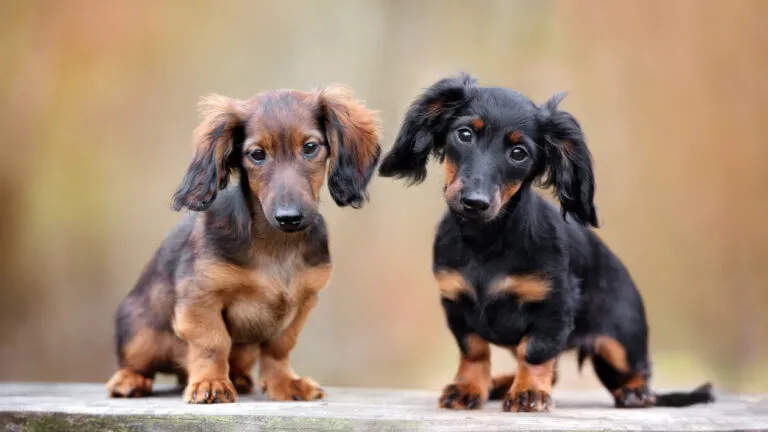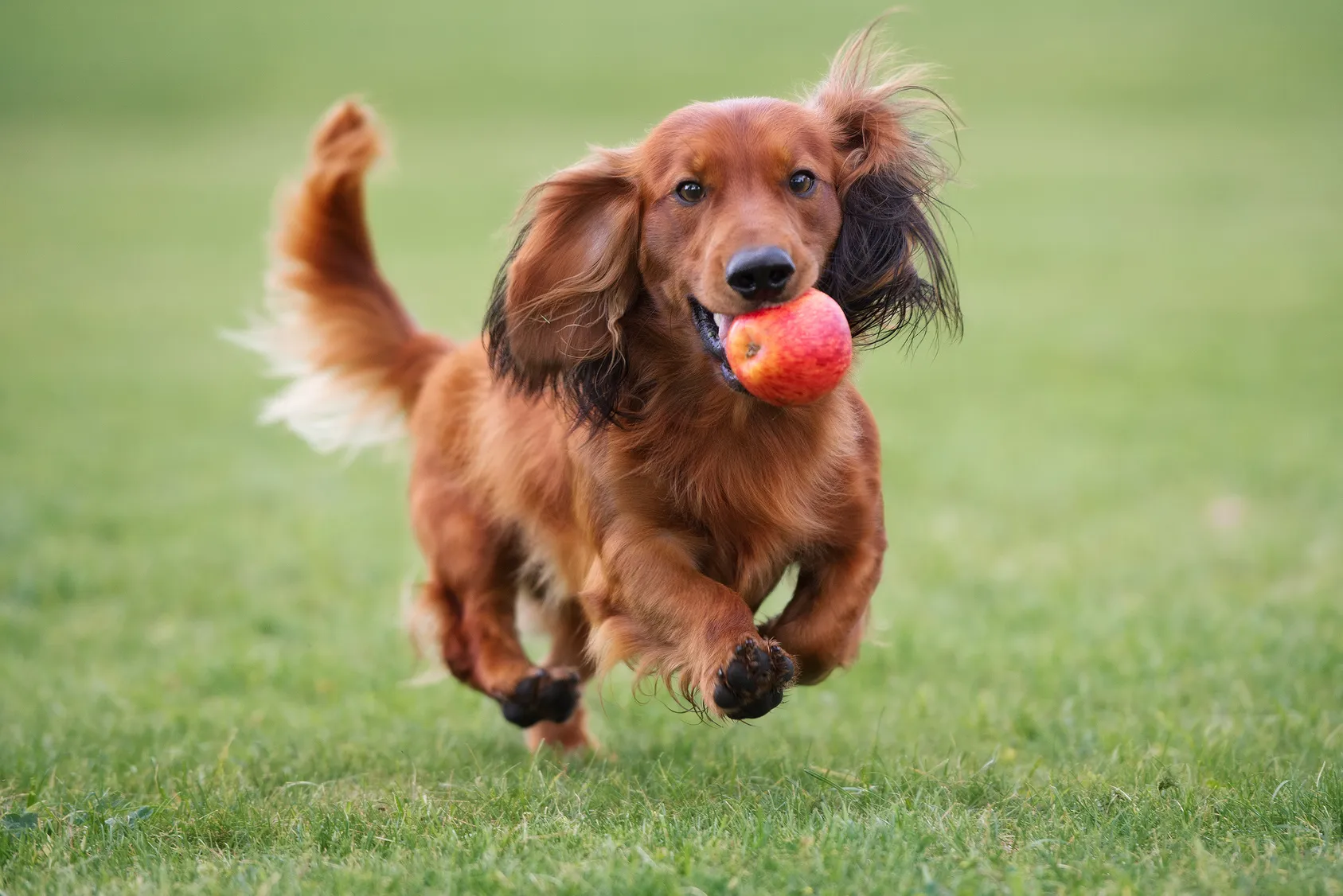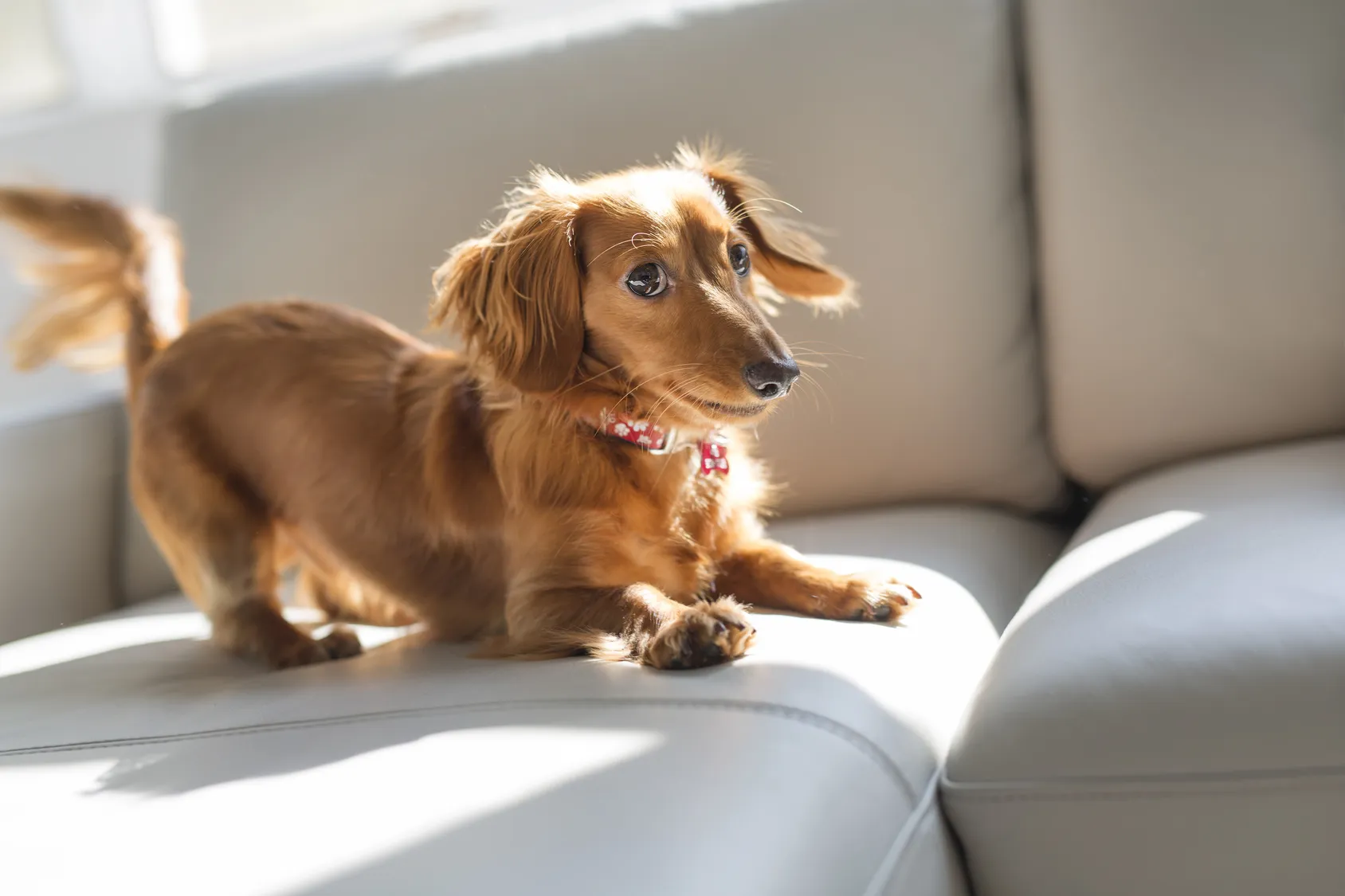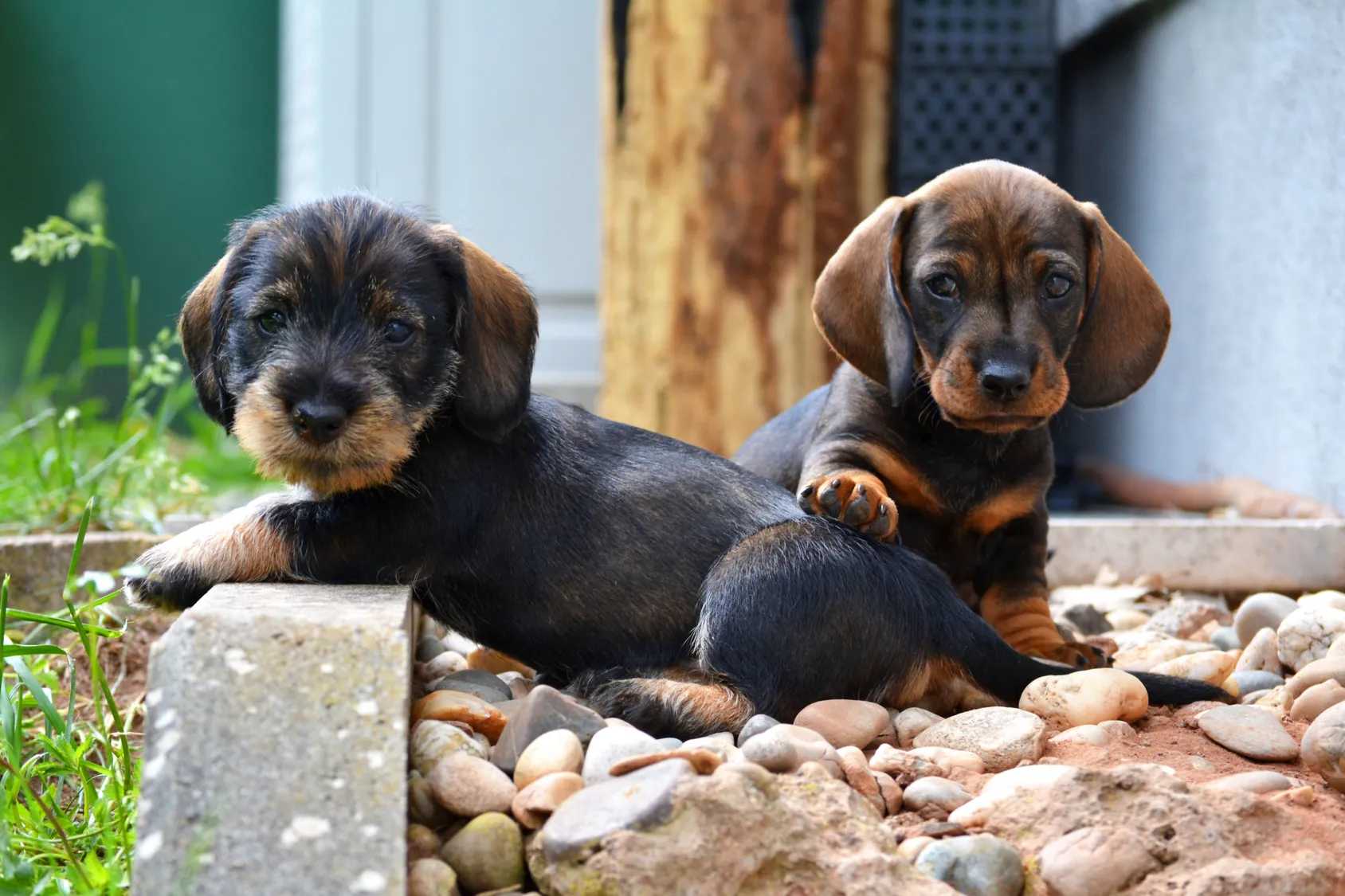Beagle
The Beagle's short legs can be deceiving – this medium-sized dog keeps you on your toes and is always full of surprises! This friendly breed is active, fearless and extremely clever.
The proverbial puppy dog eyes have melted the hearts of many animal lovers. Here you can learn all about the compact Dachshund, also known as the Teckel or Dackel.

© otsphoto / stock.adobe.com
Dachshunds are easily recognisable by their typical physique, with short legs carrying a muscular, elongated body. The upright head with drooping ears is also part of the breed standard. A further characteristic is the long back in relation to the rest of the body, which is responsible for the light-hearted nickname “sausage dog”. Despite their little legs, Dachshunds are generally very fleet of foot. These compact dogs are divided into three size categories, of which the largest is the Teckel, weighing up to 9kg. The toy Dachshund is slightly smaller, with a chest circumference of 30 to 35cm and weighing from 6-7kg. The smallest is the rabbit Dachshund, which weighs a maximum of 3kg and has a chest circumference of just 30cm.
This popular breed is also diverse in terms of its fur, since the three size categories can also be subdivided into three hair types respectively. There’s the silky, glossy long-haired Dackel, the slightly bristly Dachshund with wiry fur and a spruce beard, as well as the short-haired Dackel with flat fur. All three different lengths can be admired in many colour shades: there are monocolour Dackels in red, yellow or reddy-yellow, two-tone Dackels in a black-brown combination and spotted Dachshunds with a dark base colour and lighter spots. White is excluded, however, so that in terms of colour the Dachshund still blends in with its favourite woodland environment.
 © otsphoto / stock.adobe.com
© otsphoto / stock.adobe.com
Dachshunds originally come from Germany, where they were likely bred in a targeted manner in the Middle Ages with the Bracken. There have been official breeds for owners even outside the aristocracy since the end of the 19th century, but there has only been a breed standard since 1925. The name says is all: “Dachshunds” were dependable companions for hunters and were mainly used to hunt badgers (“Dachs” in German) and foxes. Their short legs made it possible for them to enter fox and badger dens, so the Dachshund’s task mainly involved frightening prey animals away from the burrow, as getting involved in fights with forest dwellers was not advisable. The four-legged hunter shows its diverse qualities above ground too though, for instance, when searching for traces. Nowadays Dachshunds are well-loved companion dogs and are only rarely deployed purely as utility dogs.
One of the famous friends of the breed was Napoleon Bonaparte, who was more than happy to be depicted with Dachshunds and even named one of his dogs “Napoleon”. After their death, his last canine companions found their final resting place alongside the world-famous leader’s tomb. As hunting dogs, Dachshunds were for a long time a privilege of the nobility, therefore were more than able to wrap many powerful individuals around their little finger. Kaiser Wilhelm II even erected a memorial to Erdmann, his favourite Dachshund, with the inscription “In memory of my loyal Dachshund Erdmann (1890-1901) W[ilhelm] II”. Britain’s Queen Elizabeth II may be renowned for her love of Corgis, but even she can’t resist the Dachshund charm, breeding “Dorgis”, a cross between Dachshunds and Corgis. Creative minds also prize these clever little dogs that provide a rich source of inspiration. The painter Pablo Picasso and his Dachshund called Lump were considered inseparable, as is made evident by many photos of the harmonious pair together. The artist Andy Warhol immortalised his Dachshunds Archie and Amos in many of his works.
Once Dachshunds were no longer merely a privilege of the nobility, they soon won the hearts of many dog lovers all across Europe, but especially in Germany, where these short-legged dogs sauntered alongside their owners in both towns and the countryside. Their popularity as family dogs grew rapidly. Despite the occasionally mockery of this dog also known as the “sausage dog”, with its notorious plastic effigy called the Bobblehead that decorates countless car dashboards, the breed continues to boast a large core fanbase that admires these clever, self-assured companions.
A small but highly self-aware dog: Conditioned by the Dachshund’s original deployment and its autonomous work for the hunt, these small dogs are often extremely self-confident. This can often hold the potential for conflict even in encounters with large dogs, because some Dachshunds wilfully refuse them the appropriate deference. Since they work autonomously, they prefer to decide for themselves how long the job should take. Dachshunds with a strong will to please that joyfully await new tasks in order to make their owners happy are in a clear minority. This means for Dachshund lovers that it’s necessary to begin with loving but consistent training as early as the puppy phase. This also strengthens the connection between dog and owner, which should be developed with care. Even though they generally tend to show little respect to other dogs and humans, Dachshunds are usually even-tempered companions with neither fearful nor aggressive tendencies.
 © ololia / stock.adobe.com
© ololia / stock.adobe.com
The Dachshund’s short legs can prove fatal, as they can bring on premature ossification which can cause crooked limbs. Due to the combination of the long back in relation to the rest of the body and the long spine, they are also susceptible to a certain type of slipped disc known as Dachshund paralysis. This entails constricted nerves in the spine that make the dog lose its ability to control its back legs, for instance. As is so often the case, preventing is far better than curing: maintaining strong back muscles through lots of activity as well as keeping a healthy weight protect your Dachshund from this disease so typical of the breed. Although paralysis is irreversible once it has set in, the symptoms can be alleviated through medication, physiotherapy or surgical intervention. Stairs can facilitate the onset of Dachshund paralysis, so make sure your dog handles steps and stairs with care. Wire-haired Dachshunds are the most robust members of the breed, but they are also renowned as the most stubborn.
So, you want to move a Dachshund into your home so you can be taken in by their puppy dog eyes every day? Good choice! However, a few things need to be cleared up before your new housemate moves in:
Dachshunds have a life expectancy of 15 years or more – are you ready to take on the responsibility for such a long period of time? Consider how your new housemate can be looked after should you not be present, for instance, if you fall ill or go on holiday. Nowadays many dogs can stay in hotels too – find out about the various possibilities. Speak to other Dachshund lovers to learn what it’s really like to live with these little whirlwinds. You can soon get acquainted with like-minded people online and gather tips from experienced fans of the breed. In spite of its size, a Dachshund isn’t a typical lapdog, although it does enjoy strokes and cuddles. This should be taken into account with regard to the other family members too – children should also respect this.
In order for the Dachshund to truly love the skin its in, regular grooming sessions are required. It’s best to brush your Dachshund several times a week regardless of the length of its fur. The fur of the long-haired variety of course demands a greater time commitment. With their short legs, Dachshunds love rummaging in thick undergrowth, so pay attention when brushing to see if any bugs may have ended up embedded in the fur.
Dachshunds are very stubborn, so training requires patience, empathy and a great deal of consistency. Their original deployment as autonomous hunters plays a significant role here, because it means they are able to courageously and confidently make decisions for themselves. Lay down clear rules and above all, be consistent! Dachshunds usually learn quickly what’s expected of them and stick to this. However, if you give in to the puppy dog eyes during training, your four-legged friend will shamelessly take advantage. As a hunting dog, the Dachshund generally has a strong hunting instinct, and a training goal should be to keep this under control. They should be acquainted with other dogs and children without fail as puppies to ensure they are compliant later on. This allows them to get used to other pets, but small animals “out in the wild” or on the streets, are generally always “prey” in the eyes of these passionate hunters. Only highly trained Dachshunds can be let off the leash in areas with an abundance of wildlife.
These clever dogs needs to be kept well occupied to ensure they don’t get bored. Playing fetch, searching for hidden objects in the home and garden and practising tricks are all welcome distractions for these smart dogs and what’s more, they strength the bond between human and animal. Sports such as agility aren’t suitable for these little whirlwinds, but they do love to go on long walks, and lots of activity is the best way to ward off the Dachshund paralysis typical of the breed. On trips away, there should always be sufficient time for your little sniffer dog to frolic and snuffle around at leisure.
 © Sabine Naumann / stock.adobe.com
© Sabine Naumann / stock.adobe.com
So, the breed has stolen your heart and you’ve decided to let a Dachshund move into your home? Well, the search for a new housemate can now get underway! When choosing a breeder, you should bear in mind a few factors. The breeder should unconditionally be a member of a dog club or association. Although there are some black sheep amongst them, membership of a club or association is still a fundamental characteristic of a serious breeder. The first meeting should take place in the breeder’s home, so that you can get a picture of your potential new family member’s current surroundings by becoming acquainted with both the puppies and also their parents and siblings. A serious breeder is also curious and is interested to know what sort of life its fosterlings will live in the future, so will ask questions regarding your housing situation or what you do in your free time. A purchasing contract is common practice when choosing a breeder. If you aren’t looking for a puppy, associations for homeless Dachshunds are another option, as they also offer older dogs looking out for a new home. An older dog might even already be well trained, something which foster homes are able to assess accurately. For unexperienced dog lovers, this has the advantage of them being able to give a home to an adult Dachshund without having to take on the complete training process that is of vital importance for this breed. Both breeders and intermediaries for older dogs can give you good advice here! In local animal homes too you can sometimes find Dachshunds looking forward to a new home.
However, you should definitely steer clear of supposedly low-cost Dachshunds from bargain breeders who favour quantity over quality. Whilst a breeder who has put their heart and soul into breeding Dachshunds that are true-to-type in terms of health and character wants them to go to a responsible owner and live a healthy life, illicit breeders are only concerned about profit. Here the puppies are separated much too early from their mother, who is often treated as a mere “puppy machine”. This can cause them to suffer from social and health deficits, which can lead to heavy financial costs. Many puppies are chronically ill or after being purchased develop diseases that arise from their loveless past. Dachshunds fans and animal lovers should take a long-term perspective here and not make any purchases on the grounds of pity, since every puppy sold at a bargain price supports the demand for low-cost animals. True lovers of the breed know that a Dachshund from a good home is invaluable!
We wish you and your clever Dachshund a wonderful life together!
The Beagle's short legs can be deceiving – this medium-sized dog keeps you on your toes and is always full of surprises! This friendly breed is active, fearless and extremely clever.
The Golden Retriever is still one of the most popular dog breeds, especially with families. It is defined not just by its docility, but shows numerous other qualities too. Read in the following article everything you need to know about the Golden Retriever.
The German Shepherd is one of the most popular utility dog breeds in the world, though the willing-to-learn and people-focused nature of these versatile dogs also makes them suitable for family life.